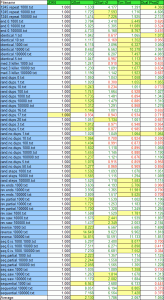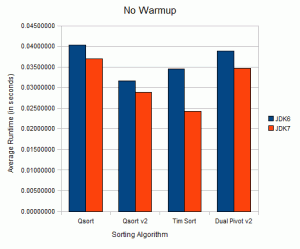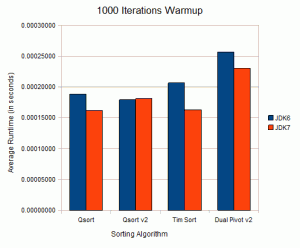Sort Optimization (Part 2) with JDK 6 vs JDK 7
In part 1, I went over my first foray into the world of sorting algorithms. Since then, I’ve had some other ideas on how to improve my quicksort implementation. One idea that I had while originally working on the sorting algorithm, was to rework the partition function to take into account duplicate elements. I had a few different working implementations, but all of them came with severe performance penalty. I finally figured out a way to get performance close to the previous algorithm.
The partition function needs to perform the minimal number of swaps possible. So moving towards the center from both ends and only swapping when both are out of order is the best approach I’ve found so far. When grouping duplicate elements, they are swapped to the beginning of the partition area as they are found. Then at the end, a pass is run to move them to their correct location in the final list. Then instead of returning one number from the partition function, it returns two. It returns the minimum and maximum indices on the range that has the pivot value.
Another area that I was able to get some performance gain out of was getting rid of the shell sort form the first algorithm. While that was there to make sure the quicksort did not recurse too deeply, in practice the shell sort algorithm doesn’t run.
Results
Here are the results of JDK 6 MergeSort, Tim Sort, QSort, QSortv2, and Dual Pivot sort 2 benchmarked on the same set of files. Overall, the new version doesn’t outperform the old version, but I thought it was worth posting my findings. On most data sets with duplicates it does perform better. I ran these benchmarks on OpenJDK 7 because I was curious as to how they would compare to one another.
It’s important to note that the tables are speedup relative the Java implementation on the given JDK. The graphs are the average runtimes for each algorithm. The reason for doing the average runtime is that it could show the performance difference between Sun’s JDK 6 and OpenJDK 7 build 73.
Conclusions
Overall the new version of the Qsort implementation doesn’t improve greatly over the previous implementation. While it didn’t work out to be the performace improvement I was looking for. I think the last graph with 1000 iterations of warmup for each algorithm is the most interesting. The Qsort v2 implementation apparently doesn’t get handled any better by OpenJDK 7. The partition function is larger after my changes, so perhaps it didn’t JIT very well. What is interesting is the boost that Tim Sort saw with the change of JDK’s. Running these benchmarks made me realize that upgrading my Java Runtime will increase the performance of all my Java applications. It will be interesting to see if the performance carries over to Netbeans and Eclipse; I expect it will.
In: Java · Tagged with: benchmarks, shootout, sorting






